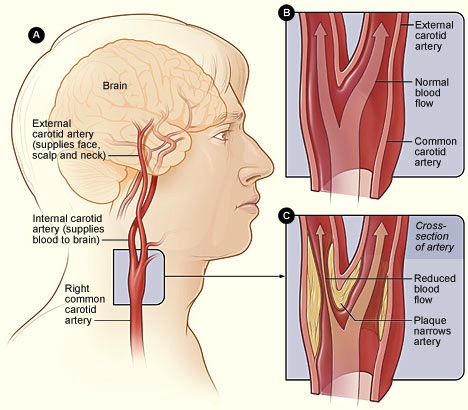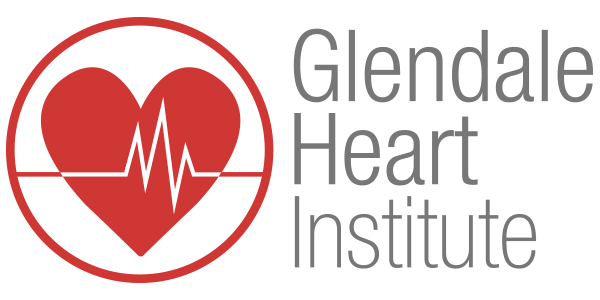
Carotid (ka-ROT-id) artery disease is a disease in which a waxy substance called plaque (plak) builds up inside the carotid arteries. You have two common carotid arteries, one on each side of your neck. They each divide into internal and external carotid arteries.
The internal carotid arteries supply oxygen-rich blood to your brain. The external carotid arteries supply oxygen-rich blood to your face, scalp, and neck.
Carotid Arteries
Figure A shows the location of the right carotid artery in the head and neck. Figure B shows the inside of a normal carotid artery that has normal blood flow. Figure C show the inside of a carotid artery that has plaque buildup and reduced blood flow.
Carotid artery disease is serious because it can cause a stroke, also called a “brain attack.” A stroke occurs if blood flow to your brain is cut off.
If blood flow is cut off for more than a few minutes, the cells in your brain start to die. This impairs the parts of the body that the brain cells control. A stroke can cause lasting brain damage; long-term disability, such as vision or speech problems or paralysis (an inability to move); or death
The internal carotid arteries supply oxygen-rich blood to your brain. The external carotid arteries supply oxygen-rich blood to your face, scalp, and neck.
Carotid Arteries
Figure A shows the location of the right carotid artery in the head and neck. Figure B shows the inside of a normal carotid artery that has normal blood flow. Figure C show the inside of a carotid artery that has plaque buildup and reduced blood flow.
Carotid artery disease is serious because it can cause a stroke, also called a “brain attack.” A stroke occurs if blood flow to your brain is cut off.
If blood flow is cut off for more than a few minutes, the cells in your brain start to die. This impairs the parts of the body that the brain cells control. A stroke can cause lasting brain damage; long-term disability, such as vision or speech problems or paralysis (an inability to move); or death
Overview
If plaque builds up in the body’s arteries, the condition is called atherosclerosis (ATH-er-o-skler-O-sis). Over time, plaque hardens and narrows the arteries. This may limit the flow of oxygen-rich blood to your organs and other parts of your body.
Atherosclerosis can affect any artery in the body. For example, if plaque builds up in the coronary (heart) arteries, a heart attack can occur. If plaque builds up in the carotid arteries, a stroke can occur.
A stroke also can occur if blood clots form in the carotid arteries. This can happen if the plaque in an artery cracks or ruptures. Blood cell fragments called platelets (PLATE-lets) stick to the site of the injury and may clump together to form blood clots. Blood clots can partly or fully block a carotid artery.
A piece of plaque or a blood clot also can break away from the wall of the carotid artery. The plaque or clot can travel through the bloodstream and get stuck in one of the brain’s smaller arteries. This can block blood flow in the artery and cause a stroke.
Carotid artery disease may not cause signs or symptoms until the carotid arteries are severely narrowed or blocked. For some people, a stroke is the first sign of the disease.
Outlook
Carotid artery disease causes more than half of the strokes that occur in the United States. Other conditions, such as certain heart problems and bleeding in the brain, also can cause strokes.
Lifestyle changes, medicines, and medical procedures can help prevent or treat carotid artery disease and may reduce the risk of stroke.
If you think you’re having a stroke, you need urgent treatment. Call 9–1–1 right away if you have symptoms of a stroke. Do not drive yourself to the hospital.
You have the best chance for full recovery if treatment to open a blocked artery is given within 4 hours of symptom onset. The sooner treatment occurs, the better your chances of recovery.
Content Resource: http://www.nhlbi.nih.gov/health/health-topics/topics/catd/
If plaque builds up in the body’s arteries, the condition is called atherosclerosis (ATH-er-o-skler-O-sis). Over time, plaque hardens and narrows the arteries. This may limit the flow of oxygen-rich blood to your organs and other parts of your body.
Atherosclerosis can affect any artery in the body. For example, if plaque builds up in the coronary (heart) arteries, a heart attack can occur. If plaque builds up in the carotid arteries, a stroke can occur.
A stroke also can occur if blood clots form in the carotid arteries. This can happen if the plaque in an artery cracks or ruptures. Blood cell fragments called platelets (PLATE-lets) stick to the site of the injury and may clump together to form blood clots. Blood clots can partly or fully block a carotid artery.
A piece of plaque or a blood clot also can break away from the wall of the carotid artery. The plaque or clot can travel through the bloodstream and get stuck in one of the brain’s smaller arteries. This can block blood flow in the artery and cause a stroke.
Carotid artery disease may not cause signs or symptoms until the carotid arteries are severely narrowed or blocked. For some people, a stroke is the first sign of the disease.
Outlook
Carotid artery disease causes more than half of the strokes that occur in the United States. Other conditions, such as certain heart problems and bleeding in the brain, also can cause strokes.
Lifestyle changes, medicines, and medical procedures can help prevent or treat carotid artery disease and may reduce the risk of stroke.
If you think you’re having a stroke, you need urgent treatment. Call 9–1–1 right away if you have symptoms of a stroke. Do not drive yourself to the hospital.
You have the best chance for full recovery if treatment to open a blocked artery is given within 4 hours of symptom onset. The sooner treatment occurs, the better your chances of recovery.
Content Resource: http://www.nhlbi.nih.gov/health/health-topics/topics/catd/
Cardiac Specialty Care
• Structural Heart Disease
• TAVR
• CardioMEMS (Heart Failure)
• PFO Closure
• TAVR
• CardioMEMS (Heart Failure)
• PFO Closure
• Coronary Intervention
• Complex Higher-Risk (And Indicated) Patients (CHIP) Angioplasty
• Atherectomy
• Impella and ECMO Support
• Complex Higher-Risk (And Indicated) Patients (CHIP) Angioplasty
• Atherectomy
• Impella and ECMO Support
• Peripheral Angioplasty
• Varicose Vein Treatment (Venous Ablation)
• DVT thrombectomy - IVC filter
• Carotid Stenting
• Varicose Vein Treatment (Venous Ablation)
• DVT thrombectomy - IVC filter
• Carotid Stenting
• Rhythm Management
• Pacemaker
• Holter Monitoring
• Exercise Stress Test
• Echocardiography
• Nuclear Stress Test
• Enhanced External Counterpulsation (EECP)
• Pacemaker
• Holter Monitoring
• Exercise Stress Test
• Echocardiography
• Nuclear Stress Test
• Enhanced External Counterpulsation (EECP)
